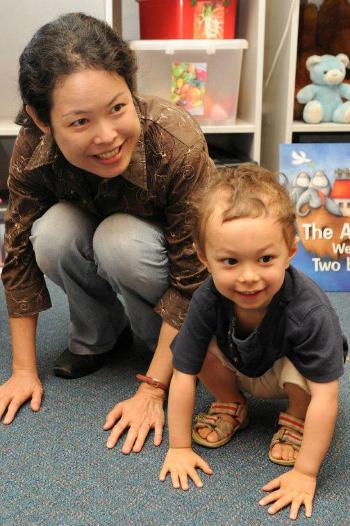Movin' and groovin' with rhymes
Duration/age

Children naturally want to move and be active and will try out different ways for their bodies to move. You can combine language with your child’s natural interest in moving.
As you talk, sing or chant with your child you can combine action rhymes and words with movement patterns. Take turns leading the rhyming and instructions. You could make up nonsense words that rhyme.
Stand up tall and then curl up small.
Run to the hall and then roll like a ball.
As you play together, ask your child if they are able to hear and identify any words that sound the same. Sometimes they might not be able to. You can help them to hear words that rhyme by saying the words together.
I can hear some words that sound the same. Fall, ball, hall and crawl all sound similar.
Where is Pop? We can all _ _ _.
What action sounds like Pop?
Materials you will need
- Your voice
- Your body
Skills this activity improves
Why does this matter?
Combining action, movement and rhymes helps your child to develop language and listening skills. As your child listens to what you are saying they will be listening for directions, instructions and words that sound the same.
As they listen to you talk or sing they are learning that words are made up of different sounds. There are sounds at the beginning, middle and end of words. Being able to hear the different sounds within a word is an important skill. A word can sound the same but the beginning letter or sound can change the meaning of the word.
What does this lead to?
When children are able to hear and discriminate between sounds and patterns within speech they are developing an understanding that each letter has its own sound.
As they listen carefully they will hear and begin to identify that there are sounds at the beginning, middle and end of words. Once they can identify individual sounds they will begin to identify where else they can hear the same sound.
'My name starts with a B. Bat and book also start with a B.'
Being able to identify sounds within words and individual sounds helps a child learn to spell words, read and write.
Language to use
- Hop, jump, run, crawl, roll, fall, clap
- Body, movement
- Sound, listening, hearing
- Same, different
Questions to use
- How many different ways can you move your body?
- Can you hear another word that sounds the same?
- What rhymes with hop?
Useful tips
- Information about hearing, sound and language development can be found in your child's health record in the Blue Book.
- For more information about developing language and literacy skills see the activities Reading together and Singing with your baby.
- If you are concerned about your child's hearing talk to your local doctor.
- Remember to talk to your child in your home language.
More ideas
- Make your own music shakers. Can you make two that sound the same?
- Borrow sound lotto games from your local library.
- Borrow books with audio sections from your local library.
Variation by age
Three to five year olds
- Sing songs together that contain rhymes and repeated sounds.
- Play sound games together.
- Change your voice to sound like different characters as you read a story together.
- Put out musical instruments to play.
- As you read together identify sounds that are the same.
- Go on a sound hunt, recording the sounds around the house.
- Make a different ringtone for each member of the family. Can your child tell who is ringing?
Questions to ask
- Which is the soft sound? Which is the loud sound?
- Who makes that sound?
- Where is that sound coming from?
- What sound does a dog make?
- Can you find another sound the same?
- Can you find another word that sounds like cat?
Language to use
- Loud, soft
- Quick, long, short
- Rhyme, rhythm, tone, pitch
- Same, different, similar


